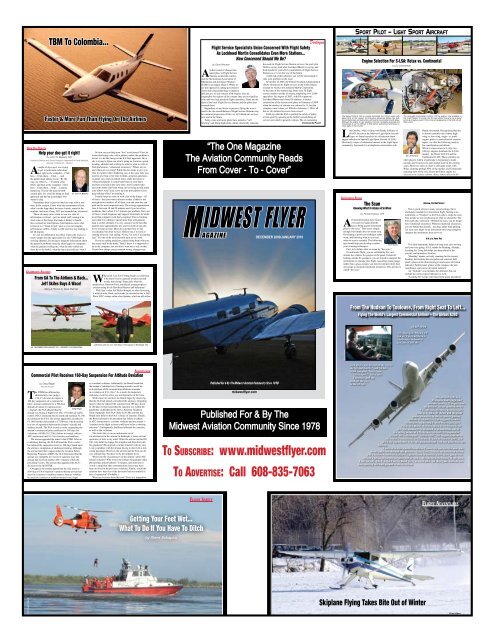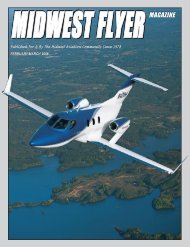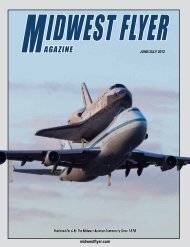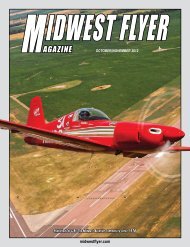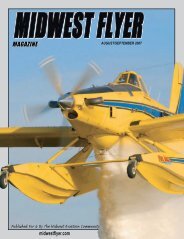AGAZINE - Midwest Flyer
AGAZINE - Midwest Flyer
AGAZINE - Midwest Flyer
You also want an ePaper? Increase the reach of your titles
YUMPU automatically turns print PDFs into web optimized ePapers that Google loves.
26 FEBRUARY/MARCH 2010 MIDWEST FLYER M<strong>AGAZINE</strong><br />
Ed Leineweber Column Word heading 9/14/08 4:09 PM Page 1<br />
TBM To Colombia…<br />
Faster & More Fun Than Flying On The Airlines<br />
by Guilherme Schmidt<br />
had to attend a business meeting in Cartagena,<br />
Colombia. The meeting started with a cocktail meeting<br />
HigH On HealtH<br />
on Wednesday. In order to make the meeting at 5:00<br />
So how can you pm, help flying your commercially, “doc” avoid errors? I would First, be have to leave the day<br />
Help your doc get it right!<br />
aware that being prior, a doc with fly all a patient, day to unless Bogota, the problem and catch is a following morning<br />
by John W. Beasley, MD<br />
trivial, is a bit like flight being to on Cartagena. the ILS final Flying approach. myself He or just made more sense,<br />
Professor Emeritus and Clinical Professor, Department of Family Medicine she is trying to figure and would out what’s be going more on fun (location, that going speed,<br />
University of Wisconsin - Madison<br />
through airline security.<br />
heading, altitude) and working to achieve what we call, in<br />
There were three of us that needed to attend the meeting.<br />
couple of days ago I was trying<br />
both professions, “situational awareness.” Where are we<br />
to get a medication order done<br />
and where are we I going? hold an While Airline the doc Transport needs to Pilot give you (ATP) certificate and<br />
A just right in the computer – Click<br />
time to explain what’s fly for bothering a hobby. you, I own at the a same Socata time TBM you 850, which is a<br />
here… Click there… Click…. and<br />
need to give him single-engine or her time to think, turboprop compose pressurized questions, airplane. One of my<br />
the patient kept talking to me. “By the<br />
examine you, read colleagues consultant notes, did not make feel decisions comfortable or flying in a single-engine<br />
way, my elbow Building is…” I looked our at his track record on write prescriptions. I cannot both listen to your heart<br />
plane over the ocean to Colombia and took the commercial<br />
elbow years and as the back program at the chair, computer. I’ve stressed Click the program's and Program have you chairs talk were: at the Oscar-winning same time. And actor I cannot and pilot, make Cliff<br />
80 years of client satisfaction. route. He left on Tuesday in order to be there on Wednesday<br />
here… message Click of earned there… reward, Oops… showing I almost young people that, decisions Robertson about (1992-1993); your heart and when the you’re first pilot trying to break to talk the about<br />
started by disciplining my 78-year-old and applying man on themselves, birth they can earn your sound elbow. barrier, And Chuck afternoon. I may Yeager screw (1994-2003).<br />
up your prescription if you<br />
control marvelous pills. rewards, It’s a bit such like as being the on freedom final and Dr. thrill John W. of Beasley keep Highlights talking while of Harrison I’m The entering TBM Ford’s it. flies chairmanship at a cruise of speed the EAA of 310 knots in ISA<br />
approach flight,” Ford and said. having “Now, a passenger Sully and who Jeff will add an<br />
Young It really Eagles helps Program conditions, to come include with burning the a list following: of about the things 50 gph. – all It is well equipped with<br />
wants emphasis to chat. on the value of training, preparation, and<br />
of them • Nearly – that 500,000 you boots want young for to discuss icing people conditions, so received that, if there inspirational and is not has two Garmin 530s, a<br />
teamwork. Sometimes No there one could is just bring too much more to credibility cope with in at sharing one enough first-flight time Young to address<br />
GMX200,<br />
Eagles all experiences of them, you<br />
and Honeywell<br />
while and your he chaired doc can<br />
Efis 40.<br />
the<br />
The TBM 850 has a<br />
time. these In concepts the cockpit, with I our have youth.” what the instruments tell me, pick program. out the most important ones. The average appointment<br />
what’s range of just over 1,400 nm, making the trip very doable.<br />
Sullenberger on the Jepp and chart, Skiles the accepted notes I made, the offer sound to of lead the time • is He between personally 10 and raised 20 considerable minutes and if funds you have for the four<br />
airplane, the program and more. in discussions Dang, ATC with just Poberezny amended and my Ford clearance! that problems, program by that’s donating about The two auction 2 to 5 of minutes items, us decided such per problem. as to movie-set leave Not on a lot Wednesday morning. I<br />
took There place are during many this times year’s when EAA we are AirVenture in a state Oshkosh of<br />
of experiences. time to reach diagnoses left home and at suggest 6:15 am treatments, and we let were alone wheels up at 7:00 am.<br />
information (Wisconsin). overload – just too much stuff coming at us. do all • He the elevated computer the work<br />
We specialize in airport planning and design!<br />
We stature took that’s of off the required. from Gathering Time Flying of is Eagles limiting Cloud Municipal Airport<br />
And, Skiles some of and the Sullenberger things that make were it inspired harder to get handle involved and event, while which I’m takes willing<br />
(FCM) place to spend during more<br />
Eden EAA time<br />
Prairie, AirVenture with patients<br />
Minnesota Oshkosh, and flew nonstop to Fort<br />
this in the overload program are during interruptions. 800.325.2055 their visit Interruptions at AirVenture. • www.sehinc.com<br />
cause A native what of than to make is on it the a more schedule, effective I’m very fundraising sensitive vehicle to the for fact the that<br />
Lauderdale, Florida (FLL), and then nonstop to Cartagena,<br />
is Wisconsin, known ARCHITECTS as a Skiles “break had in | been task” ENGINEERS a and, regular as | you PLANNERS to the can annual imagine, | SCIENTISTS fly-in. patients program. have appointments too, and it is both of our jobs<br />
performance This was Sullenberger’s suffers. I reply first to time ATC to and the now event. my heading is to try • He to keep enhanced on Colombia time. the program's Most docs (SKCG). public do their profile best and to stay exposure.<br />
off 20 For 14 degrees. Skiles, FEBRUARY/MARCH a rekindled enthusiasm 2010 MIDWEST for flight FLYER fueled M<strong>AGAZINE</strong> his on schedule, • He emphasized but often the we “ambassadorship” fail. Believe me, I’m message, tired of<br />
acceptance It’s not too of different the co-chair in my role. office. “I’m Unless grateful the to issue EAA is and a starting underscoring off every the visit EAA saying, Young “Gosh, Eagles I’m Program's sorry I’m significant running<br />
really the AirVenture simple one Oshkosh (the equivalent convention of a for nice allowing VFR flight me to at fall late!” potential It’s one to enhance of the most the image stressful of general parts of aviation my work. among<br />
cruising in love with altitude), aviation I’m for trying a second to integrate time in information my life. I’m about eager policymakers If you are taking and the medicines, broad public. please bring them with you;<br />
the to share patient’s this problems passion with from young the chart people (paper and or encourage computer), the actual • He personally stuff in the provided bottle. Yeah, flights I know to nearly it is 300 supposed Young to<br />
what participation the patient in is aviation,” telling me, he said. what the non-verbals are be Eagles. in the computer, but you don’t want me to rely on that.<br />
(how The or EAA she Young looks), Eagles what the Program, nurse just now told in its me, 17th what I I know Sporty’s how things Pilot Shop, can get in entered partnership wrong, with changes EAA, provides may<br />
remember year, has provided and more inspirational as I work to and figure educational out what’s firstflight<br />
what experiences to do about to it nearly all. 1.5 million youth, thanks to systems. inspired Trust by the me, Young I’ve Eagles been there. flight experience to continue<br />
going on not free be online recorded flight and training errors to can participating be perpetuated youth by who computer are<br />
and<br />
the In volunteer aviation, efforts the FAA of has 42,000 mandated EAA member a rule that pilots there and is Winona StateDark pursuing Please an – 3/20/05 pretty interest please! in 1:51 aviation. – PM avoid Page ConocoPhillips what 1 we docs call is the the<br />
no countless extraneous supporters. conversation (the “sterile cockpit”) under “hand presenting on the sponsor doorknob” of the problem. EAA Young A while Eagles back Program. I had<br />
10,000 In addition feet (where to Ford, the workload previous is EAA higher) Young for Eagles the airlines. finished Learn more up a at 15-minute www.youngeagles.org.<br />
visit with a very complex – and q<br />
This is recognizing that there is only so much we can wonderful – elderly patient and as I had my hand on the<br />
handle at one time.<br />
doorknob (literally!), her husband says: “You know, she’s<br />
Grassroots From my aviation perspective, we need some version of that rule hallucinating in the mornings.” Talk about a show stopper!<br />
in medical care as well.<br />
Now I’m running hat good 45 minutes is an EAA behind Young schedule. Eagles co-chairman It’s a little<br />
From GA To The Airlines & Back…<br />
if he doesn’t have a general aviation aircraft<br />
From Springfield, Illinois To Madison Wto take kids flying? Especially when his<br />
Jeff Skiles Buys A Waco! predecessor, Harrison Ford, introduced young people to<br />
Only 10 Minutes Away!<br />
WINONA STATE UNIVERSITY<br />
aviation using his de Havilland Beaver and helicopter?<br />
Story & At Photos 1,572 by mph! Dave Weiman<br />
YOUR<br />
Well, that’s what Jeff Skiles thought, so after discussing<br />
– Pat O’Malley’s Jet Room Restaurant – it with PATHWAY his wife, Barb, and friends, he decided to buy a 1935<br />
Dane County Regional Airport – Madison, Wis. (MSN) Waco TOYOC THEvintage cabin-class biplane, which an old airline<br />
Wisconsin Aviation – East Ramp<br />
AIRLINES<br />
Breakfast & Lunch<br />
WHILE LANDING AN EDUCATION<br />
6 a.m. - 2 p.m. Mon. thru Sat.<br />
8 a.m. - 2 p.m. Sunday<br />
1-800-DIAL-WSU<br />
Pam & Pat O’Malley<br />
608-268-5010<br />
(An FAA Airway Science University)<br />
16 DECEMBER 2009/JANUARY 2010 MIDWEST FLYER M<strong>AGAZINE</strong><br />
56 DECEMBER 2009/JANUARY 2010 MIDWEST FLYER M<strong>AGAZINE</strong><br />
I<br />
Jeff Skiles with his new 1935 Waco YOC biplane in Brodhead, Wis.<br />
AviAtion LAw<br />
Commercial Pilot Receives 160-Day Suspension For Altitude Deviation<br />
by Greg Reigel<br />
as a residual violation. Additionally, the Board found that<br />
Attorney At Law<br />
the airman᾽s “admitted act of turning around to assist his<br />
sick grandson while encountering turbulence amounts<br />
he NTSB has affirmed an<br />
to a violation of § 91.13(a).” As a result, the inspector's<br />
administrative law judge᾽s<br />
testimony, even if in error, was not dispositive of the issue.<br />
T(“ALJ”) decision to impose a<br />
With respect to sanction, the Board began by observing<br />
160-day suspension of a commercial<br />
that the ALJ had already considered the airman᾽s mitigating<br />
pilot᾽s airman certificate for a 500-foot<br />
factors when he reduced the sanction from 180 days down<br />
altitude deviation. In Administrator<br />
to 160 days. It then noted that the sanction was within the<br />
Greg Reigel<br />
v. Saghafi, the FAA alleged that the<br />
guidelines established in the FAA᾽s Sanction Guidance<br />
airman was flying at flight level (FL) 170 when air traffic Table (Appendix B to FAA Order 2150.3B) and that the<br />
control (ATC) instructed him to climb and maintain FL 180. Board must defer to the FAA᾽s choice of sanction. Finally,<br />
According to the FAA, the airman apparently ascended to the Board referred to its precedent that failure to adhere<br />
FL 180, but then descended to 17,500 feet, which resulted to ATC instructions is a serious violation and the airman᾽s<br />
in a loss of separation between the airman᾽s aircraft and “conduct on the flight at issue could have led to a sobering<br />
another aircraft. The FAA issued an order suspending the outcome.” Consequently, the Board affirmed the sanction,<br />
airman᾽s commercial pilot certificate for 180 days for as well as the violations.<br />
violations of FARs 91.123(b) (failure to comply with an This looks like it was an unfortunate set of<br />
ATC instruction) and 91.13(a) (careless and reckless). circumstances for the airman. In hindsight, it raises several<br />
The airman appealed the order to the NTSB. After an questions, at least in my mind. When the airman reached FL<br />
evidentiary hearing, the ALJ affirmed the FAA᾽s order, 180, why didn't he engage the autopilot and then deal with<br />
but reduced the suspension down to 160 days based upon his grandson? (Having had a similar situation with my son,<br />
the airman᾽s completion of additional training. Although I can sympathize with the airman having to deal with a sick,<br />
the airman had filed a report under the Aviation Safety young passenger. However, the aircraft and the FAA can be<br />
Reporting Program (ASRP), the ALJ determined that the very unforgiving. You have to fly the airplane first.)<br />
airman was ineligible for waiver of sanction since the<br />
What were the circumstances of the airman᾽s prior ATC<br />
airman had received another ATC violation within the related violation? Why wasn᾽t the airman using proper radio<br />
preceding 5 years. The airman then appealed the ALJ᾽s phraseology and procedures? (I suspect, and mind you it<br />
decision to the full NTSB.<br />
is only a suspicion, that communication issues may have<br />
On appeal, the airman argued that the ALJ erred in been involved in the previous violation.) Finally, would the<br />
allowing an FAA inspector's opinion that the airman had sanction have been less if the deviation had not resulted in<br />
acted in a careless or reckless manner, because whether loss of separation? (Probably.)<br />
he acted in a careless or reckless manner was a legal<br />
What can we learn from this case? First, it is imperative<br />
conclusion about which the inspector was not qualified to that proper phraseology and radio procedures be used to<br />
testify. He also argued that the inspector᾽s testimony that ensure that communications are clear and understood.<br />
he “deliberately” deviated from the ATC instruction was Second, when problems/distractions arise in the cockpit,<br />
incorrect because the airman did not hear the instruction. flying the airplane should remain the pilot᾽s first priority<br />
With respect to sanction, the airman argued that a 160- and only then should the pilot try and deal with the<br />
day suspension was excessive, because it was based on a problem/distraction.<br />
finding that he acted in a careless or reckless manner. He © Reigel & Associates, Ltd.-Aero Legal Services 2010.<br />
Omnni 10/8/04<br />
further argued that it should have been mitigated by the fact All rights 5:12 reserved. PM Page 1<br />
that he had a sick passenger on board, that he incorrectly EDITOR̓S NOTE: Greg Reigel is an attorney with<br />
heard the ATC instruction, that he had had no additional Reigel & Associates, Ltd., a law firm located in Hopkins,<br />
violations, and that he had taken affirmative steps to<br />
Minnesota, which represents clients in aviation and business<br />
law matters (www.aerolegalservices.com, 952-238-1060,<br />
prevent such miscommunication in the future.<br />
greigel@aerolegalservices.com).<br />
In rejecting the airman᾽s appeal, the Board initially<br />
observed that the airman had not shown that the ALJ erred<br />
by allowing the inspector᾽s opinion that the airman had acted<br />
OMNNI ASSOCIATES<br />
in a careless or reckless manner. It then went on to note<br />
“Airport Engineering and Design Services”<br />
that the airman did not appear to dispute that he violated<br />
For Additional Information Contact<br />
FAR 91.123(b) when he failed to maintain FL 180 and, as a<br />
Aaron Stewart At 920-735-6900<br />
result, that violation supported a violation of FAR 91.13(a)<br />
ONE SYSTEMS DRIVE, APPLETON, WI 54914<br />
“The One Magazine<br />
The Aviation Community Reads<br />
From Cover - To - Cover”<br />
M<br />
q<br />
Getting Your Feet Wet…<br />
What To Do If You Have To Ditch<br />
FEBRUARY/MARCH 2010 MIDWEST FLYER M<strong>AGAZINE</strong> 35<br />
by Steve Schapiro<br />
A<br />
Dialogue<br />
Flight Service Specialists Union Concerned With Flight Safety<br />
As Lockheed Martin Consolidates Even More Stations...<br />
How Concerned Should We Be?<br />
by Dave Weiman<br />
nother round of changes has<br />
taked place at Flight Service<br />
Stations around the country,<br />
and the International Association of<br />
Machinists and Aerospace Workers<br />
(IAM) is not happy about it. While we<br />
are not opposed to cutting government<br />
waste and using technology to improve<br />
efficiencies, we are concern with briefers who are<br />
responsible for regions of the country they are not familiar<br />
with and who lack practical flight experience. Gone are the<br />
days of the local Flight Service Station and the pilots that<br />
manned them.<br />
Regardless of any desire to preserve flying the way it<br />
used to be, the consolidation of Flight Service Stations may<br />
be a natural progression of how we will obtain our services<br />
now and in the future.<br />
Today, more and more pilots have turned to “self<br />
briefing” and filing flight plans online, drastically reducing<br />
IDWEST FLYER<br />
<strong>AGAZINE</strong> DECEMBER 2009/JANUARY 2010<br />
Published For & By The <strong>Midwest</strong> Aviation Community Since 1978<br />
midwestflyer.com<br />
the need for Flight Service Station services. So read what<br />
IAM is saying, read what Lockheed Martin is saying, and<br />
then decide for yourself if consolidation of Flight Service<br />
Stations is or is not the way of the future.<br />
At the end of this editorial, you will be encouraged to<br />
state your position on the issue.<br />
In October of 2005, the Federal Aviation Administration<br />
(FAA) outsourced its flight services in the United States<br />
(except for Alaska) to Lockheed Martin Corporation.<br />
At the time of the outsourcing, there were 58 flight<br />
service stations outside of Alaska, employing over 2,000<br />
specialists. By August of 2007, with FAA approval,<br />
Lockheed Martin had closed 38 stations. A further<br />
constriction of the system took place in February of 2009<br />
when the number of stations was reduced to 13, but the<br />
company wasn’t done yet. Effective February 1, 2010, all<br />
but six (6) stations have now been closed.<br />
IAM says that the FAA is putting the safety of pilots<br />
at risk again by agreeing to the further consolidation of<br />
services provided to general aviation. The six remaining<br />
Continued on Page 8<br />
FEBRUARY/MARCH 2010 MIDWEST FLYER M<strong>AGAZINE</strong> 5<br />
Published For & By The<br />
<strong>Midwest</strong> Aviation Community Since 1978<br />
To SubScribe: www.midwestflyer.com<br />
To AdverTiSe: Call 608-835-7063<br />
Flight SaFety<br />
Ed Leineweber<br />
L<br />
SPORT PILOT – LIGHT SPORT AIRCRAFT<br />
Engine Selection For S-LSA: Rotax vs. Continental<br />
The Rotax 912ULS 100 hp engine dominates the S-LSA scene with<br />
about 80% of the market. Its innovative, advanced design has both<br />
fervent defenders and detractors, with points to be made on both sides.<br />
Although the engine is very reliable in service if properly operated and<br />
maintained, it can be difficult to find factory authorized technicians in<br />
many parts of the country.<br />
ast October, while visiting with Randy Schlitter of<br />
RANS Aircraft at the <strong>Midwest</strong> Light Sport Aircraft<br />
Expo, we found ourselves in a discussion about<br />
engine selection in Special Light Sport Aircraft (S-LSA).<br />
Obviously a topic of substantial interest in the Light Sport<br />
community, I pursued it in a telephone conversation with<br />
F light Design<br />
U s A<br />
Instrument FlIght<br />
The Scan<br />
Knowing What To Glance At & When<br />
by Ed Leineweber<br />
The venerable Continental O-200-A 100 hp engine, now available in<br />
the "Light Weight" D model. Will the new edition prove to be as bullet<br />
proof as its aging cousin? Only time and experience in the field will tell.<br />
Stay tuned.<br />
Randy last month. Recognizing that this<br />
is almost certainly one of those highwing<br />
vs. low-wing, single- vs. multiengine,<br />
pitch vs. power kind of aviation<br />
topics, we offer the following analysis<br />
for consideration and debate.<br />
When it comes down to it, only two<br />
100-h.p. engines dominate the S-LSA<br />
market: the Rotax 912ULS and the<br />
Ed Leineweber<br />
Continental O-200. There certainly are<br />
other players. Jabiru in particular is beginning to make<br />
inroads, and I expect it to gain market share in the coming<br />
years. However, since its share is still quite small, with<br />
Rotax claiming perhaps 80% of the market, and Continental<br />
enjoying most of the rest, I leave the Jabiru engine for<br />
discussion in a future column. (Since Jabiru offers the 85-<br />
h.p. model 2200 and the 120-h.p. 3300, it would be difficult<br />
in any event to work it into an apples-to-apples comparison<br />
with the 912ULS and O-200.)<br />
What makes the Rotax/Continental comparison fun<br />
are the strong feelings (we won’t call them “prejudices”),<br />
which animate any discussion of Rotax engines, especially<br />
This is good advice in many social settings, but is<br />
absolutely mandatory in instrument flight. Staring at an<br />
by Richard Morey, CFII<br />
instrument, or “fixation” as the FAA calls it, stops the scan.<br />
This means we are not glancing at what we should be. The<br />
ll instrument pilots have heard<br />
FAA calls this “omission.” Without the scan, you no longer<br />
over and over again that the<br />
have situational awareness. Without situational awareness,<br />
Akey to being a good instrument<br />
you are behind the aircraft…reacting, rather than guiding.<br />
pilot is “the scan.” This seems simple<br />
Let your eyes linger on an instrument only long enough to<br />
enough, but simple does not mean easy.<br />
interpret the instrument, then move on.<br />
Developing a good scan technique takes<br />
LSA NorthFeb09_2.indd work, and 1 knowing what to scan and<br />
1/25/09 4:42:09 PM<br />
H A L Is Your Pal<br />
when to scan is essential. The following<br />
tips should help you develop or refine<br />
Rich Morey This little mnemonic helps you keep your eyes moving<br />
your scanning techniques:<br />
and your scan going. H A L stands for Heading, Altitude,<br />
First, let’s define what we mean by “the scan.”<br />
Looking for. Using this helps you keep ahead of the<br />
In instrument flight, you are substituting the view<br />
aircraft, and minimizes fixation.<br />
outside the window for gauges on the panel. Instead of<br />
“Heading” means, not only scanning for the correct<br />
looking outside for guidance, you are forced to interpret the<br />
heading, but tracking the navigation aid selected. Full<br />
instruments to manage your flight. Assuming steam gauges<br />
panel: glance at the directional gyro and course deviation<br />
rather than a glass cockpit, you need to interpret more than<br />
indicator. Partial panel: glance at the compass, the turn<br />
one gauge to maintain situational awareness. This process is<br />
coordinator, and course deviation indicator.<br />
called “the scan.”<br />
An “Altitude” scan includes the altimeter, but can<br />
include the vertical speed indicator as well.<br />
“Looking for” keeps your mind in the game and ahead<br />
of the airplane. In a turn, we are “looking for” a heading.<br />
En route or on approach, we may be “looking for” VOR<br />
passage, a vector from center, an intersection, a distance or<br />
perhaps interception of a radial, bearing or localizer. With<br />
every frequency change, “look for” the engine instruments<br />
as well.<br />
Bruno Sarda<br />
Another bit of good social advice. In flight, we should<br />
From The Hudson To Toulouse, break down From large tasks Right into small Seat segments and To scan Left… in<br />
Flying The World’s Largest Commercial frequency while Airliner fixating on – the The radio Airbus display, tune A380 one<br />
12 DECEMBER stick all 2009/JANUARY the way 2010 aft and MIDWEST all FLYER the way M<strong>AGAZINE</strong> to<br />
the left and hold it,” said Airbus<br />
A380 test pilot, Terry Lutz.<br />
“Helicopter!” Terry said.<br />
I dutifully pull the<br />
stick all the way<br />
to the aft left.<br />
Glance, Do Not Stare!<br />
Don’t Bite Off More Than You Can Chew<br />
between. For example, instead of dialing in the entire new<br />
digit at a time and then scan in between. Another nice radio<br />
technique is to simply count the clicks while continuing<br />
your scan, then glance at the radio to confirm that you<br />
counted by correctly Jeff Skiles and have the right frequency dialed in.<br />
Assume we have to change frequencies from Madison<br />
“Ok, flaps (Wisconsin full. When – MSN) I tell tower, 119.3, to Middleton Municipal<br />
you we’ll Airport, pretend Morey there Field’s is (C29) CTAF of 123.0. On my old<br />
a helicopter KX170B, in front I simply of grabbed the large tuning knob and<br />
you, you’ll counted pull four the clicks clockwise. This advanced the frequency<br />
from 119 to 123. Then I would grab the little knob and count<br />
12 clicks counter clockwise to go from .30 to .00. On the<br />
big knob, one click was one full MHz…the little knob was<br />
one click equals .25 MHz. Once you figure out your radio,<br />
you should have no problem changing frequencies with only<br />
a few glances for confirmation. This skill is guaranteed to<br />
wow your safety pilot, instructor or even examiner.<br />
The aircraft rolls to a<br />
45-degree bank angle and<br />
assumes about a 25-degree noseup<br />
attitude. As the speed slows to<br />
Vso, the auto-throttles automatically<br />
come in to take-off thrust and the giant<br />
plane pirouettes in the air, slowly gaining<br />
altitude at 16,000 feet. The rugged Pyrenees<br />
Mountains, separating France from Spain, give<br />
way to the placid Mediterranean as we rotate in the<br />
sky. This maneuver is designed to demonstrate one of<br />
the selling points of a fly-by-wire aircraft; it’s impossible<br />
to stall. We’re flying the “Airbus A380,” the largest airplane in<br />
the world! I was invited to Toulouse, France in October 2009, and<br />
given the opportunity to fly this grand aircraft with test pilots from the<br />
factory.<br />
I arrived in this beautiful southern France city and met the man who<br />
would guide me through this process – Terry Lutz. Terry is an American citizen<br />
and a former Northwest Airlines Captain based in Detroit. A few years ago he was<br />
offered a job as an Airbus test pilot and he took it. Having seen the beauty of this area,<br />
I can see why. The U.S. Air Force trained Terry as a test pilot. All these years later, he has<br />
been putting that background to use at Airbus.<br />
Flight Adventures<br />
Ed Leineweber<br />
Dave Weiman<br />
U.S. Coast Guard<br />
Skiplane Flying Takes Bite Out of Winter<br />
Elroy Hilbert<br />
W<br />
U.S. Coast Guard water rescue.<br />
hen Captain Chesley B. “Sully” Sullenberger<br />
and First Officer Jeffrey B. “Jeff” Skiles ditched<br />
their U.S. Airways Airbus A320 (Flight 1549)<br />
Aviation Maintenance<br />
Technician Degree Program<br />
Story by Allen Penticoff<br />
t has been a long held<br />
desire of mine to fly a<br />
Luscombe 8A on takeoff.<br />
South St. Paul Municipal Airport<br />
Richard E. Fleming Field (SGS)


